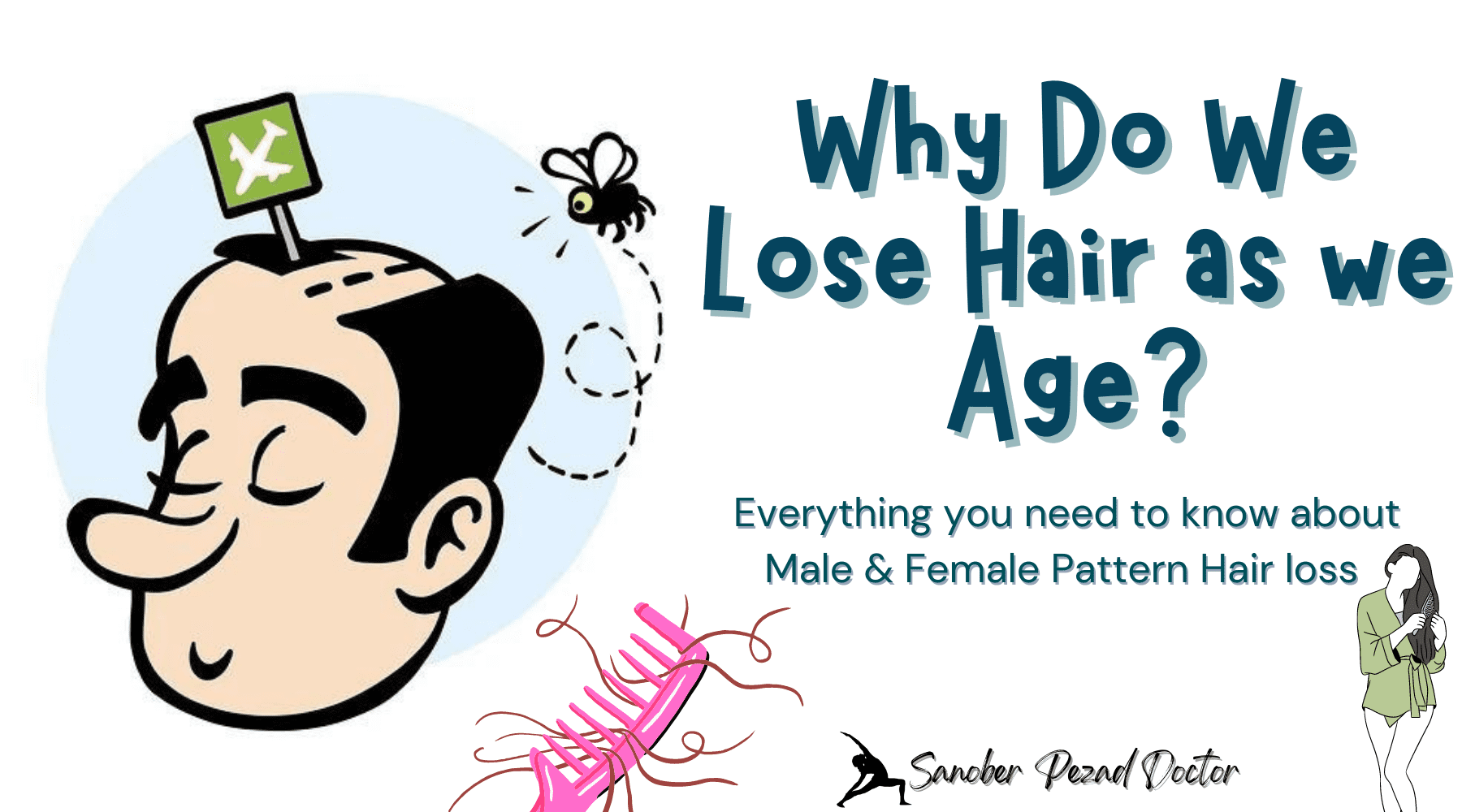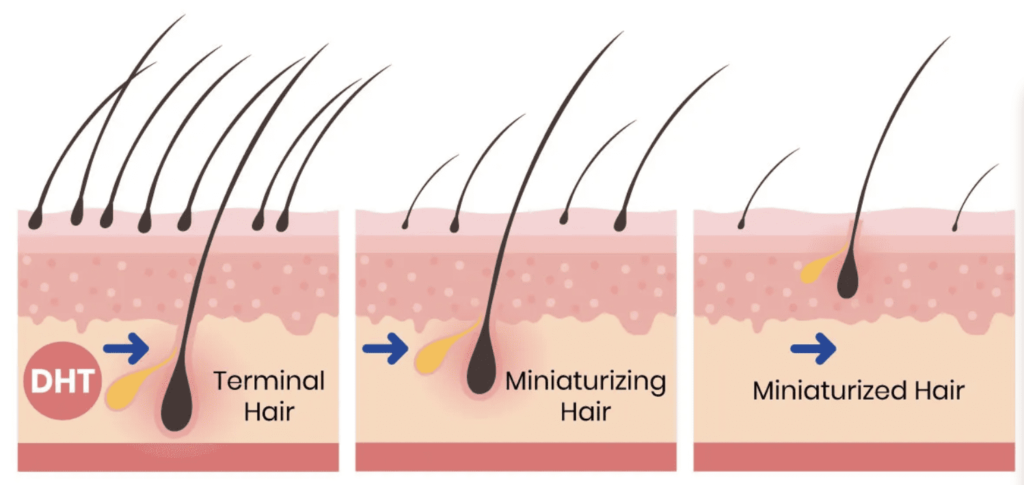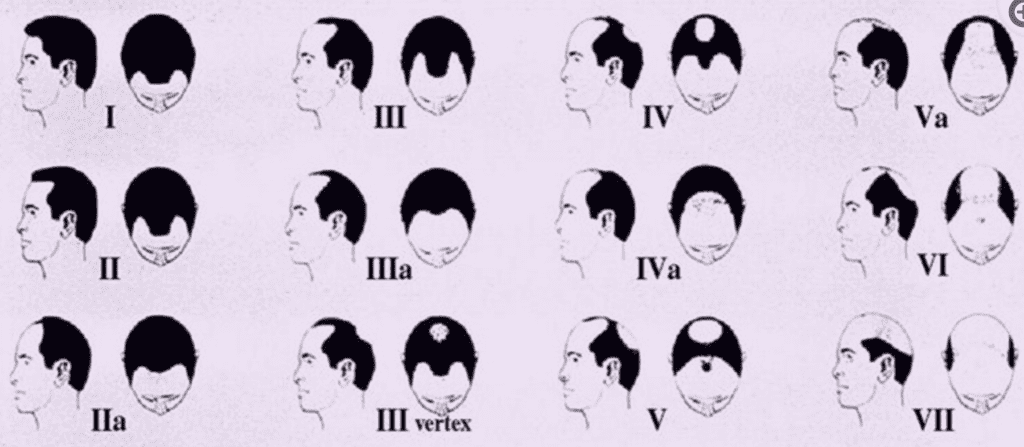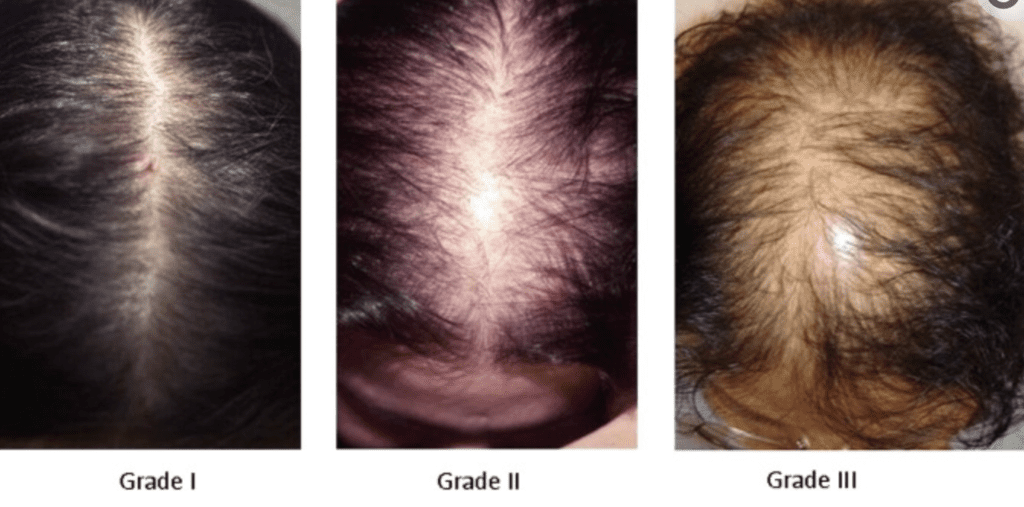Why Do We Lose Hair as we Age?- Everything you need to know about Male & Female Pattern Hair loss (Androgenetic Alopecia)

Hair has always played an important role in the history of mankind. The Egyptian civilization paid heed to the importance of hair, not only because it looked appealing, but also because of the erotic symbolism connected with it. The Romans considered hair as a symbol of beauty, masculinity, class, and intellect. And in today’s time, having a head full of healthy hair is considered a sign of youthfulness and vitality.
Now there are a few celebrities like Ricki Lake and Rosie O’Donnell who have spoken about suffering from severe androgenetic alopecia openly, but if you still considered that most in the media industry flaunting thick locks of hair even in their 60s is all-natural, then I’ll have to burst your bubble and make you aware about the complete truth!
But as you age, your body experiences many changes, and your hair is no exception. For most people, this hair loss associated with the aging body is often a sign of significant distress. I know of thousands of people who have got deeply affected by their balding scalps causing them significant social anxiety and interfering with their well-being.
Hence, I want to share the understanding of how and why we lose hair as we age so that you can stay worry-free (calm as a cucumber) knowing that its occurrence is not entirely your fault and that what is meant to happen, is inevitable!
Why Do We Lose Hair as we Age?
By now, you know too well that hair is made up of the protein- Keratin. And you might also remember that every hair follicle undergoes a cycle of ‘Growth, Rest, and Regress’. A single strand of hair has a normal life of about two to seven years and our hair grows an average of 0.5 inches a month and six inches a year. [In case you missed it or want to refresh your basics about hair essentials, you can catch it up here- Hair & Scalp Basics: Hair Facts that you Must Know ]
Now our hair just like every other part of the body ages. This means that the hair we once had, will slowly get replaced by shorter, finer hair, which occurs as a consequence of miniaturization.
This further means that the duration of each cycle of ‘Growth, Rest and Regress’ shortens, leading to thinner and finer hair as time goes by. But why should that happen you may ask?
What are the causes of Patterned Hair Loss or Age-related thinning?
There are a number of factors to blame. The theories that were proposed to be causing this form of hair thinning and hair loss before are being challenged and proven from time to time. But for the sake of simplification and understanding, I like dividing the causes into 3 broad categories.
Miniaturization of Hair can be caused by:
- Genetic Predisposition
- Age
- Hormonal Influence- specifically the hormone known as dihydrotestosterone (DHT)
Or a combination of all 3!
When it comes to genetics, there has been documentation of the Baldness trait being present over the X chromosome gene. This means that if your mother’s father experienced hair miniaturization, you’re more likely to also experience it. But it can also pass from the father’s side. In fact, there is a familial predisposition to patterned hair loss with sons at a five to six times higher relative risk if their fathers were balding.
Simply put if you have a strong family history of age-related patterned hair loss in your family, there is a high chance that you or your subsequent generations may develop it at an earlier age.
For e.g.- My father, grandfather, and great grandfather…(and I am assuming the generations of my paternal family before too) all experienced severe patterned hair loss and the same is true in my mother’s family as well. Hence, I am not surprised to see myself and my little one having fine and scarce hair inherently in the region of the temple!
Another important determinant is the hormone- DHT. Dihydrotestosterone (DHT) is a male sex hormone derived from testosterone and belongs to the group of androgens. The conversion of testosterone to DHT is regulated by the enzyme Type 2 5 alpha-reductase enzyme which plays an important role in this hair loss by facilitating the process of hair follicle miniaturization.
In fact, the previous and more popular name of this condition in the medical world is – Androgenetic Alopecia since it was believed to occur due to an excessive response to androgens.
What does Hair Follicle Miniaturization mean?
Hair follicle miniaturization is a technical term for hair thinning or balding. What this literally means is that the coarse terminal hair present over the scalp turns into vellus-like hair of the body. This is almost opposite to the changes taking place in boys during puberty.
Under the influence of DHT, the anagen i.e. growth phase of the hair shortens, thereby leading to shorter, finer hair over time.


thinner and more brittle, as well as fall out faster.
Ref- https://www.dyna-nutrition.com/dht-a-hormone-that-causes-hair-loss-in-male-both-and-female/
When does Male and Female Patterned Hair loss Begin?
While the focus tends to be on men when it comes to patterned hair loss and the terminology Androgenetic Alopecia is partial towards the male sex too, I want you to remember that age-related patterned hair loss can affect BOTH MEN and WOMEN.
Male Pattern Hair loss is the most common cause of hair loss in men and it usually begins after midlife. It is believed that by the age of 50, more than half of the men will see visible signs of patterned hair loss such as thinning, a receding hairline, or balding. But I have seen of late, many young boys coming in with patterned hair loss, starting as early as late teens or early twenties.
For most women, Female Pattern Hair loss begins more commonly after menopause. But it is known to begin in midlife, when a woman is in her 40s, 50s, or 60s, though it can begin earlier for some women.
How can you Identify Patterned Hair Loss or Age-related thinning?
This type of Patterned baldness usually tends to develop slowly. It may begin simply as a receding hairline or a bald spot on the top of your head and can cause thinning and hair loss for years.
1. Grading/Classification of Male /Female Pattern Hair Loss
In men, the hair loss may begin in the area of the temples or the crown of the head i.e. from the side angles or the top portion of the head respectively. Some men may just develop a single bald spot in the center of the head. While a majority may of others experience their hairlines receding to form an “M” shape. In some men, the hairline may recede in a “U” pattern and this may continue until all or most of the hair is gone.
Below is the image of one of the most popular classification systems that Dermatologists/Trichologists use to categorize the severity of Male Pattern Hair Loss.


Women do not lose all of their hair, as do some men. Instead, women tend to notice that their hair partition often gets wider. I want you to refer to the Image below which shows the progression and severity of Female Pattern Hair Loss.


.


Br J Dermatol, Volume 155, Issue 5, 1 November 2006, Pages 926–930, https://doi.org/10.1111/j.1365-2133.2006.07409.x
To summarize, the symptoms of patterned hair loss and hair miniaturization that you should look out for include:
- a receding hairline
- thinning of the hair at the crown or top of the head
- a widening midline partition
Needless to say, if you are experiencing hair loss more than usual and you suspect any form of hair loss, you must consult your Dermatologist/Trichologist.
Thereafter, he/she will examine your scalp with a Trichoscope (a Dermatologist’s Stethoscope) to see the number of Miniaturized hair present over the scalp).
2. Perform The ‘Hair Pull Test‘
In addition to the visual grading that we just went through, a good way to determine whether you are actively losing hair is to perform the ‘Hair Pull Test’, which you can try at home too.
To do the Hair Pull test:
- Grab a very small section of hair (about 60 hairs) between your index finger and thumb as close to the scalp as possible.
- Give a gentle but firm pull straight upwards to see if any hair breaks or comes out in its entirety.
- If more than three-four hair come out, this means the hair pull test is positive and the cause needs to be further investigated.
3. Keep a Visual Record
If you suspect your hair is thinning, or for that matter, if you suspect any form of hair loss, it is a very good practice to take photos and keep its record right from the very beginning. Here are some points to keep in mind for best record-keeping.
- Take photos of the top of your head every month
- Take photos of the side of your head every month
- Keep the distance between the camera and the head the same
- Take the photographs while keeping the head at the same angle
The more identical the photos will be, the easier it will be for you and your doctor to compare and gauge the progress and severity of the condition.
To conclude, the Aging of hair is an inevitable process that is determined by an interplay of many factors including weathering, grooming habits, UV exposure, and patterned hair loss. Now that we have understood what exactly is patterned hair loss and how to diagnose it, we will learn the Best Treatment Strategies for it in the coming article.
A very good read to learn more about the details of androgenetic alopecia for my geek fellows is this book- Androgenetic Alopecia From A to Z: Vol.1 Basic Science, Diagnosis, Etiology, and Related Disorders
Till then, sending lots of healthy and happy wishes your way. ?
P.S.- If you like what I share, consider Subscribing to stay connected & Up to Date with the latest Pearls of Wisdom. I do NOT spam. Promise! ?
Also, please leave a comment and share the article with your loved ones. Sharing is Caring!
Feel free to ask a question or leave a suggestion as well. I am always open to learning. ?
References
- Androgenetic Alopecia- https://www.ncbi.nlm.nih.gov/books/NBK430924/
- Cause of Androgenic Alopecia: Crux of the Matter- https://www.ncbi.nlm.nih.gov/pmc/articles/PMC4174066/
- Hair pull test: A clinical update for patients with Asian- and Afro-textured hair- https://pubmed.ncbi.nlm.nih.gov/33326824/
- Cause of Androgenic Alopecia: Crux of the Matter- https://www.ncbi.nlm.nih.gov/pmc/articles/PMC4174066/
- 12 Female Celebrities Who Opened Up About Their Battle with Hair Loss- https://stylecaster.com/beauty/female-celebrities-hair-loss/
- Female Pattern Hair Loss- https://link.springer.com/chapter/10.1007/978-3-030-76111-0_12







Comments
So proud to see you doing so well! Doing what you always wanted to do… Help others. Sending lots of love ❤️
Thank you so much!